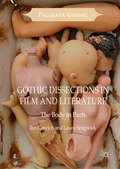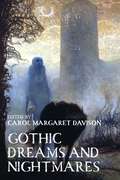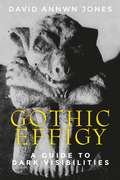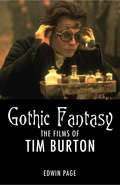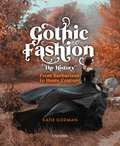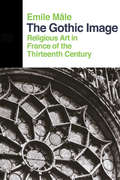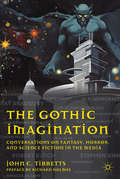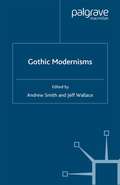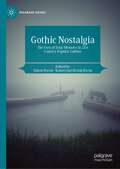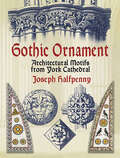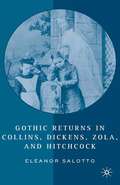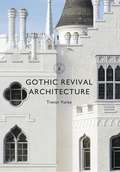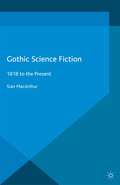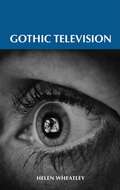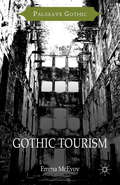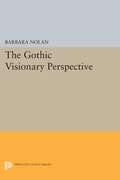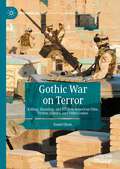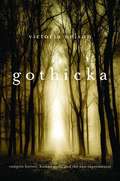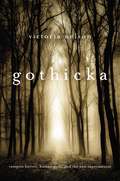- Table View
- List View
Gothic Dissections in Film and Literature: The Body in Parts (Palgrave Gothic)
by Ian Conrich Laura SedgwickThis is the first book-length study to systematically and theoretically analyse the use and representation of individual body parts in Gothic fiction. Moving between filmic and literary texts and across the body—from the brain, hair and teeth, to hands, skin and the stomach—this book engages in unique readings by foregrounding a diversity of global representations. Building on scholarly work on the ‘Gothic body’ and ‘body horror’, Gothic Dissections in Film and Literature dissects the individual features that comprise the physical human corporeal form in its different functions. This very original and accessible study, which will appeal to a broad range of readers interested in the Gothic, centralises the use (and abuse) of limbs, organs, bones and appendages. It presents a set of unique global examinations; from Brazil, France and South Korea to name a few; that address the materiality of the Gothic body in depth in texts ranging from the nineteenth century to the present; from Nikolai Gogol, Edgar Allan Poe, Roald Dahl and Chuck Palahniuk, to David Cronenberg, Freddy Krueger and The Greasy Strangler.
Gothic dreams and nightmares
by Carol DavisonGothic dreams and nightmares is an edited collection on the compelling yet under-theorised subject of Gothic dreams and nightmares ranging across more than two centuries of literature, the visual arts, and twentieth- and twenty-first century visual media. Written by an international group of experts, including leading and lesser-known scholars, it considers its subject in various national, cultural, and socio-historical contexts, engaging with questions of philosophy, morality, rationality, consciousness, and creativity.
Gothic dreams and nightmares
by Carol Margaret DavisonGothic dreams and nightmares is an edited collection on the compelling yet under-theorised subject of Gothic dreams and nightmares ranging across more than two centuries of literature, the visual arts, and twentieth- and twenty-first century visual media. Written by an international group of experts, including leading and lesser-known scholars, it considers its subject in various national, cultural, and socio-historical contexts, engaging with questions of philosophy, morality, rationality, consciousness, and creativity.
Gothic effigy: A guide to dark visibilities
by David Annwn JonesGothic effigy brings together for the first time the multifarious visual motifs and media associated with Gothic, many of which have never received serious study before. This guide is the most comprehensive work in its field, a study aid that draws links between a considerable array of Gothic visual works and artifacts, from the work of Salvator Rosa and the first illustrations of Gothic Blue Books to the latest Gothic painters and graphic artists. Currently popular areas such as Gothic fashion, gaming, T.V. and film are considered, as well as the ghostly images of magic lantern shows. This groundbreaking study will serve as an invaluable reference and research book. In its wide range and closely detailed descriptions, it will be very attractive for students, academics, collectors, fans of popular Gothic culture and general readers.
Gothic effigy: A guide to dark visibilities
by David Annwn JonesGothic effigy brings together for the first time the multifarious visual motifs and media associated with Gothic, many of which have never received serious study before. This guide is the most comprehensive work in its field, a study aid that draws links between a considerable array of Gothic visual works and artifacts, from the work of Salvator Rosa and the first illustrations of Gothic Blue Books to the latest Gothic painters and graphic artists. Currently popular areas such as Gothic fashion, gaming, T.V. and film are considered, as well as the ghostly images of magic lantern shows. This groundbreaking study will serve as an invaluable reference and research book. In its wide range and closely detailed descriptions, it will be very attractive for students, academics, collectors, fans of popular Gothic culture and general readers.
Gothic Fantasy: The Fims of Tim Burton
by Edwin PageEdwin Page takes us on a journey through the films of Tim Burton, through which we gain insights into the mysterious, and somewhat reclusive film director responsible for them. A book ideally suited to film studies and media studies, at school and undergraduate level, this book has analysis of the filming methods devised by Tim Burton, and descriptions of his works, including Beetlejuice, Batman, Edward Scissorhands, Batman Returns, The Nightmare Before Christmas, Ed Wood, Mars Attacks!, Sleepy Hollow, Planet of the Apes, Big Fish, Charlie and the Chocolate Factory and Corpse Bride.
Gothic Fashion The History: From Barbarians to Haute Couture
by Katie GodmanFrom the ancient barbarians responsible for the fall of Rome, to the black-lipped teenager updating their Instagram from a graveyard, Goths have been with us for a long time. Ideas about what is Gothic have changed and mutated, but a fascination with the dark and dramatic has remained a constant. The History of Gothic Fashion charts Gothic dress from its ancient and medieval origins to its various revivals and romanticised rebirths, examining its cultural inspirations including folk lore, 19th-century novels, the silver screen and rock music. For a subculture associated with literature and historical fashion, there are surprisingly few books that focus solely on Gothic fashion. The History of Gothic Fashion provides an in-depth overview of the evolution of the darker side of style.
The Gothic Image: Religious Art In France Of The Thirteenth Century
by Emile MaleEmile Male's book aids understanding of medieval art and medieval symbolism, and of the vision of the world which presided over the building of the French cathedrals. It looks at French religious art in the Middle Ages, its forms, and especially the Eastern sources of sculptural iconography used in the cathedrals of France. Fully illustrated with many footnotes it acts as a useful guide for the student of Western culture.
The Gothic Image: Religious Art In France Of The Thirteenth Century
by Emile MaleEmile Male's book aids understanding of medieval art and medieval symbolism, and of the vision of the world which presided over the building of the French cathedrals. It looks at French religious art in the Middle Ages, its forms, and especially the Eastern sources of sculptural iconography used in the cathedrals of France. Fully illustrated with many footnotes it acts as a useful guide for the student of Western culture.
The Gothic Imagination: Conversations on Fantasy, Horror, and Science Fiction in the Media
by John C. TibbettsThis book brings together the author's interviews with many prominent figures in fantasy, horror, and science fiction to examine the traditions and extensions of the gothic mode of storytelling over the last 200 years and its contemporary influence on film and media.
Gothic Modernisms
by A. Smith J. WallaceThis is the first full length exploration of the relationship between Gothic fiction and Modernism in fiction and film. The Gothic's fascination with images of the fragmented self is echoed in the Modernist concern with the psyche and the paranoia of the everyday. The contributors explore how the Gothic influences a range of writers including James Joyce, D.H. Lawrence, Virginia Woolf, May Sinclair, Elizabeth Bowen and Djuna Barnes.
Gothic Nostalgia: The Uses of Toxic Memory in 21st Century Popular Culture (Palgrave Gothic)
by Simon Bacon Katarzyna Bronk-BaconThis book is an original and innovative study of how Gothic nostalgia and toxic memory are used to underpin and promote the ongoing culture wars and populist politics in contemporary popular culture. The essays collected here cover topics from the spectral to the ecological, deep fakes to toxic ableism, Mary Poppins to John Wick to reveal how the use of an imaginary past to shape the present, creates truly Gothic times that we can never escape. These ‘hungry ghosts’ from the past find resonance with the Gothic which speaks equally of a past that often not only haunts the present but will not let it escape its grasp. This collection will look at the confluence between various kinds of toxic nostalgia and popular culture to suggest the ways in which contemporary populism has resurrected ideological monsters from the grave to gorge on the present and any possibility of change that the future might represent.
Gothic Ornament: Architectural Motifs from York Cathedral
by Joseph HalfpennyThese royalty-free motifs feature exquisite specimens of the sculptured ornaments from northern Europe's largest medieval cathedral. The Cathedral and Metropolitical Church of St. Peter in York, popularly known as York Minster, was founded as a missionary church. Its soaring Gothic architecture and vast interior, parts of which date back to the 13th century, feature some of the best examples of the medieval craftsman's work to be found anywhere.This compilation consists of 175 illustrations, selected from throughout the cathedral. Like the building of the church itself, the ornaments were executed during different eras. This collection, reproduced from a rare 18th-century volume, offers artists and graphic designers an unusual selection of authentic architectural motifs from the Middle Ages.
The Gothic Peckinpah
by Tony WilliamsThis book argues for the importance of Gothic in understanding one of the key elements within the films of Sam Peckinpah (1925-1984). Although occasionally noted in the past, the Gothic has been generally overlooked when most critics consider the work of Sam Peckinpah with the exception of the Freudian based Crucified Heroes (1979) by Terence Butler. This work not only examines the films made after that date, especially the often dismissed The Osterman Weekend (1983) and the two music videos he made for Julian Lennon, but also places the director within the context of the developing work on Gothic that has since appeared. Peckinpah has been identified as the director of one undisputed masterpiece, The Wild Bunch (1969). By focussing on the key role Gothic plays in most of the director’s work, this book offers a way to see Peckinpah beyond The Wild Bunch and the Western, viewing him as a director who had the potential of evolving further, had circumstances permitted, to continue his critique of American life within the developing lens of the Gothic.
The Gothic Peckinpah
by Tony WilliamsThis book argues for the importance of Gothic in understanding one of the key elements within the films of Sam Peckinpah (1925-1984). Although occasionally noted in the past, the Gothic has been generally overlooked when most critics consider the work of Sam Peckinpah with the exception of the Freudian based Crucified Heroes (1979) by Terence Butler. This work not only examines the films made after that date, especially the often dismissed The Osterman Weekend (1983) and the two music videos he made for Julian Lennon, but also places the director within the context of the developing work on Gothic that has since appeared. Peckinpah has been identified as the director of one undisputed masterpiece, The Wild Bunch (1969). By focussing on the key role Gothic plays in most of the director’s work, this book offers a way to see Peckinpah beyond The Wild Bunch and the Western, viewing him as a director who had the potential of evolving further, had circumstances permitted, to continue his critique of American life within the developing lens of the Gothic.
Gothic Returns in Collins, Dickens, Zola, and Hitchcock
by E. SalottoLooking at the gothic in Victorian fiction, the development of cinema and Hitchcock's Vertigo , this book explores the contained or repressed desires of both characters and plots which defy direct representation, resulting in obsession, fetishism and displacement engendering a novel account of the way in which the gothic becomes internalized.
Gothic Revival Architecture (Shire Library #840)
by Trevor YorkeFrom the Houses of Parliament to the Midland Hotel at St Pancras and Strawberry Hill House, Gothic Revival buildings are some of the most distinctive structures found in Britain. Far from a copy of medieval buildings, it was a style full of colour and invention, in which its exponents created a daring new approach to design. Throwing out the old Classical rule book, Gothic Revival architects like Pugin and George Gilbert Scott designed buildings which were asymmetrical in form and visually expressive of their function. The movement went beyond just bricks and mortar and had a strong moral code, the influence of which was still felt into the 20th century. In this illustrated book, Trevor Yorke tells the story of the Gothic Revival from its origins in the whimsical fancies of the Georgian Period through to its High Victorian climax.
Gothic Revival Architecture (Shire Library #840)
by Trevor YorkeFrom the Houses of Parliament to the Midland Hotel at St Pancras and Strawberry Hill House, Gothic Revival buildings are some of the most distinctive structures found in Britain. Far from a copy of medieval buildings, it was a style full of colour and invention, in which its exponents created a daring new approach to design. Throwing out the old Classical rule book, Gothic Revival architects like Pugin and George Gilbert Scott designed buildings which were asymmetrical in form and visually expressive of their function. The movement went beyond just bricks and mortar and had a strong moral code, the influence of which was still felt into the 20th century. In this illustrated book, Trevor Yorke tells the story of the Gothic Revival from its origins in the whimsical fancies of the Georgian Period through to its High Victorian climax.
Gothic Science Fiction: 1818 to the Present (Palgrave Gothic)
by S. MacArthurGothic Science Fiction explores the fascinating world of gothic influenced science fiction. From Frankenstein to Doctor Who and from H. G Wells to Stephen King, the book charts the rise of a genre and follows the descent into darkness that consumes it.
Gothic television
by Helen WheatleyThis book is the first in-depth study of the Gothic on television. It defines and explores key instances of the genre across the history of television drama in the UK and US. The book builds a strong argument for the fact that the Gothic, in its various guises, is well-suited to television as a domestic medium.
Gothic Tourism: Constructing Haunted England (Palgrave Gothic)
by Emma McEvoyFrom Strawberry Hill to The Dungeons, Alnwick Castle to Barnageddon, Gothic tourism is a fascinating, and sometimes controversial, area. This lively study considers Gothic tourism's aesthetics and origins, as well as its relationship with literature, film, folklore, heritage management, arts programming and the 'edutainment' business.
The Gothic Visionary Perspective
by Barbara NolanBarbara Nolan contends that attitudes toward the meaning of history, prophecy, and vision developed by religious writers of the twelfth and early thirteenth centuries fundamentally affected the shape of literary narrative and religious art for two centuries. In these essays, she explores some of the most important moments in this Gothic visionary perspective.The author first follows the history of Apocalypse commentaries from Bede to Alexander of Bremen, focusing particularly on twelfth-century interpretation of Revelation as a spiritual guidebook for the contemporary Christian. She shows that innovative interpretations in these texts have parallels in the cathedral art of St.-Denis and Chartres, the illuminations for later medieval illustrated Apocalypses, and the invention of new "anagogical" literary modes. Professor Nolan's close study of the Vita Nuova indicates that in his earliest work Dante used a prophetic voice and a graded series of visions to shape his conventional love story into a book of revelation. Examination of the thirteenth-century spiritual quest reveals that French writers, transforming older monastic forms, gave new importance to the process of conversion by way of vision. Pearl and Piers Plowman participate in the tradition of the spiritual quest even as Piers marks a final moment in its history.Originally published in 1977.The Princeton Legacy Library uses the latest print-on-demand technology to again make available previously out-of-print books from the distinguished backlist of Princeton University Press. These editions preserve the original texts of these important books while presenting them in durable paperback and hardcover editions. The goal of the Princeton Legacy Library is to vastly increase access to the rich scholarly heritage found in the thousands of books published by Princeton University Press since its founding in 1905.
Gothic War on Terror: Killing, Haunting, and PTSD in American Film, Fiction, Comics, and Video Games (Palgrave Gothic)
by Danel OlsonAfter 9/11, the world felt the “shock and awe” of the War on Terror. But that war also exploded inside novels, films, comics, and gaming. Danel Olson investigates why the paranormal, ghostly, and conspiratorial entered such media between 2002-2022, and how this Gothic presence connects to the most recent theories on PTSD. Set in New York/Gotham, Afghanistan, Iraq, and CIA black sites, the traumatic and weird works interrogated here ask how killing affects the killers. The protagonists probed are artillery, infantry, and armored-cavalry soldiers; military intelligence; the Air Force; counter-terrorism officers of the NYPD, NCIS, FBI, and CIA; and even the ultimate crime-fighting vigilante, Batman.
Gothicka: Vampire Heroes, Human Gods, And The New Supernatural
by Victoria NelsonThe Gothic has taken a revolutionary turn in this century. Today’s Gothic has fashioned its monsters and devils into heroes and angels and is actively reviving supernaturalism in popular culture. Nelson argues that this mainstreaming of a spiritually driven supernaturalism is a harbinger of what a post-Christian religion in America might look like.
Gothicka: Vampire Heroes, Human Gods, And The New Supernatural
by Victoria NelsonThe Gothic has taken a revolutionary turn in this century. Today’s Gothic has fashioned its monsters and devils into heroes and angels and is actively reviving supernaturalism in popular culture. Nelson argues that this mainstreaming of a spiritually driven supernaturalism is a harbinger of what a post-Christian religion in America might look like.
